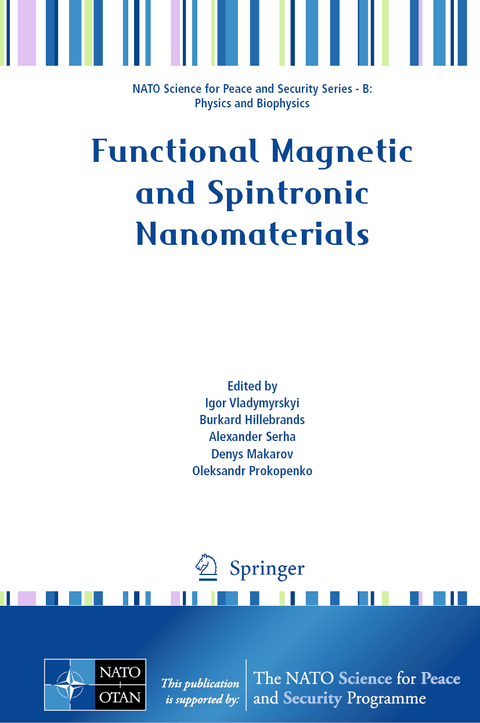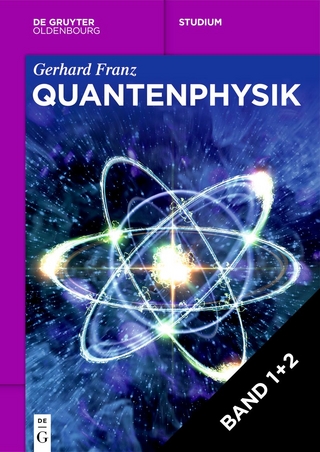
Functional Magnetic and Spintronic Nanomaterials
Springer (Verlag)
9789402422535 (ISBN)
Macroscopic objects made of magnetic materials have been known to mankind for several thousand years and are widely used in various fields of human activity. With the development and practical implementation of microelectronics, and more recently nanoelectronics, it has become possible to develop and manufacture magnetic nanomaterials, dramatically expanding the scope of magnetics in modern technologies. Today, magnetic nanomaterials and nanostructures are key components of advanced information technologies. They are widely used in eMobility, medicine, sensors, robotics, etc., and have significant potential for application in prospective smart wearables and human-machine interfaces.
This volume outlines recent research in the field of functional magnetic and spintronic materials. Each of the 10 chapters in the volume is self-contained, allowing the topics to be explored independently of the material in other chapters. The book covers the entire "life cycle" of magnetic/spintronic nanomaterials: from theoretical and numerical studies of their properties (Ch. 1), fabrication and experimental study of film systems (Ch. 2), fabrication of nanostructures (Ch. 3), study of electromagnetic phenomena occurring in such nanostructures (Chs. 4-10), to the use of these nanostructures in new technologies, particularly in spintronic energy harvesting (Ch. 9) and quantum sensing (Ch. 10).
Some of the contributions to this volume were presented as lectures and reports at the Advanced Research Workshop "Functional Spintronic Nanomaterials for Radiation Detection and Energy Harvesting" (25-27 September 2023, Kyiv, Ukraine), which was supported by the NATO Science for Peace and Security Programme.
Dr. Igor Vladymyrskyi Igor Vladymyrskyi received his Master degree (2011) in Materials Science from National Technical University of Ukraine “Kyiv Polytechnic Institute” followed by Ph.D. (2014) and Dr.Sci. (2021) degrees from Institute of Metal Physics of National Academy of Science of Ukraine. From 2022 he holds a position of director of E.O. Paton Institute of Materials Science and Welding of National Technical University of Ukraine “Igor Sikorsky Kyiv Polytechnic Institute”. Research activities are devoted to diffusion and diffusion-controlled phenomena in nanoscale magnetic thin films. Prof. Dr. Burkard Hillebrands Burkard Hillebrands is full professor of experimental physics at the University of Kaiserslautern. After studies at the University of Cologne with PhD in 1986, and postdoctoral stays at the Optical Sciences Center in Tucson, Arizona, and at RWTH Aachen, he was associate professor at the University of Karlsruhe in 1994. Since 1995 he is full professor at the University of Kaiserslautern. From 2006 to 2014 he was Vice President for Research, Technology and Innovation of University of Kaiserslautern. From 2016 to 2017 he served as Scientific Director of the Leibniz Institute for Solid State and Materials Research Dresden. His research field is experimental magnetism, in particular magnonics. He is particularly interested in nonlinear magnonic phenomena, magnonic crystals, magnon gases, magnon condensates and magnonic supercurrent phenomena in view of applications in novel information technologies such as magnon logics. In 2019-2022 he served as President of the European Magnetism Association. In 2015-2017 he was Chair of the International Union of Pure and Applied Physics (IUPAP), Commission C9: Magnetism. He is member, Chair of the Class of Mathematics and Natural Sciences, and Vice President of the Academy of Sciences and Literature, Mainz. He is member of the National Academy of Science and Engineering (acatech) and member of the European Academy of Sciences (EurASc). He is IEEE Fellow, APS Fellow and Fellow of the Institute of Physics, London. In 2016 he received an ERC Advanced Grant of the European Commission. In 2023 he received the Achievement Award of the IEEE Magnetics Society. He served on the Administrative Committee of the IEEE Magnetics Society and was Honors&Awards Chair in 2013-2018. In 2018 to 2024 he was Chair and Member of the Scientific Advisory Board of the Helmholtz Center Dresden-Rossendorf (HZDR), and also Member of the HZDR Supervisory Board. He has published more than 430 refereed articles, book contributions, and several patents. Dr. Alexander Serga Alexander Serga (a.k.a. Oleksandr Serha) received his Master's, Ph.D., and D.Sc. degrees in Radiophysics and Electronics from Taras Shevchenko National University of Kyiv in 1989, 1995, and 2006, respectively. From 1989 to 2004, he worked at the Faculty of Radio Physics of Taras Shevchenko National University of Kyiv as an engineer, Assistant, D.Sc. Research Fellow, and Docent (Associate Professor). In 2001, Dr. Alexander Serga joined the Department of Physics at the Kaiserslautern University of Technology (Kaiserslautern, Germany) as a Research Associate, and in 2006 he took a permanent position as a Senior Research Associate. In 2009, he received his Habilitation degree in experimental physics and the academic title of Privatdocent at the Kaiserslautern University of Technology (since 2023 – Rheinland-Pfälzische Technische Universität Kaiserslautern-Landau). His current research topics include spin-wave electrodynamics, magnonics, spintronics, spin caloritronics, functional microelectronics, magnon gases and magnon Bose–Einstein condensates, nonstationary nonlinear phenomena in magnetically ordered media at microwave frequencies, and other related areas. Dr. Denys Makarov Denys Makarov received his Master degree (2005) at Taras Shevchenko National University of Kyiv in Ukraine, followed by a Ph.D. in physics (2008) from the University of Konstanz in Germany. Currently, he is head of department “Intelligent materials and systems” at the Helmholtz-Zentrum Dresden-Rossendorf and leads the Helmholtz Innovation Lab FlexiSens. With his activities, Denys Makarov made a decisive contribution to the development of curvilinear magnetism and stimulated research on spintronics on flexible, bendable and stretchable surfaces. Mechanically flexible and skin-conformal magnetic field sensors enable new application scenarios for human-machine interfaces, eMobility and medicine. These activities are supported via major national and European projects including ERC Starting Grant 2012 and ERC Advanced Grant 2024. Denys Makarov is Senior Member of the IEEE and Fellow of the Young Academy of Europe. Prof. Dr. Oleksandr Prokopenko Oleksandr Prokopenko received his Master degree (2002), Ph.D. in radio physics (2006), and D.Sc. in radio physics (2016) from Taras Shevchenko National University of Kyiv in Ukraine. Currently, he is a professor and chair of the “Nanophysics and Nanoelectronics” department at the Institute of High Technologies of Taras Shevchenko National University of Kyiv. With his activities, Oleksandr Prokopenko made a decisive contribution to the development of the field of spintronic detectors and oscillators operating in the microwave and subterahertz bands and nanodevices based on these spintronic nanostructures. These activities are supported by many national and international projects. Oleksandr Prokopenko is a Senior Member of the IEEE.
1. Influence of strong electron-electron correlations on the electrical conduction and magnetic properties of substitutional alloys as advanced functional spintronic material (V.V. Lizunov, I.M. Melnyk, T.M. Radchenko, S.P. Repetsky, V.A. Tatarenko - G.V. Kurdyumov Institute for Metal Physics of the N.A.S. of Ukraine, Kyiv, Ukraine).- 2. Engineered nanocolumnar magnetic films (María Garrido-Segovia, Lidia Martínez, Yves Huttel, Saso Gyergyek, Ana Espinosa, Elena Navarro and José Miguel García-Martín - Departamento de Física de Materiales, Universidad Complutense de Madrid, Madrid, Spain; Instituto de Micro y Nanotecnología, Madrid, Spain; Instituto de Magnetismo Aplicado, Madrid, Spain; Instituto de Ciencia de Materiales de Madrid, Madrid, Spain; Department for Materials Synthesis, Jozef Stefan Institute, Ljubljana, Slovenia).- 3. Mn-based perpendicular magnetic tunnel junctions (Andreas Kaidatzis - Institute of Nanoscience and Nanotechnology, N.C.S.R. "Demokritos", Athens, Greece).- 4. Longitudinal evolution of the magnetization in nanostructure (Ivan A. Yastremsky - Taras Shevchenko National University of Kyiv, Kyiv, Ukraine).- 5. Controlling multimagnon interaction in magnetic nanodots and spintronic nanostructures (Roman Verba, Julia Kharlan, Vladyslav Borynskyi, Denys Slobodianiuk, Arezoo Etesamirad and Igor Barsukov - Institute of Magnetism, Kyiv, Ukraine; Institute of Spintronics and Quantum Information, Faculty of Physics, Adam Mickiewicz University, Poznan, Poland; Taras Shevchenko National University of Kyiv, Kyiv, Ukraine; Physics and Astronomy, University of California, Riverside, California, USA).- 6. Domain wall automotion by cross section tailoring in ferromagnetic nanostripes (Dmytro Karakuts, Kostiantyn V. Yershov, Denis D. Sheka - Taras Shevchenko National University of Kyiv Kyiv, Ukraine; Leibniz-Institut fur Festkorper- und Werkstoffforschung, IFW Dresden, Dresden, Germany).- 7. Supercritical propagation of nonlinear spin wave through an antiferromagnetic magnonic crystal (Oksana Yu. Gorobets, Volodymyr V. Kulish, Ihor A. Syzon, Daryna V. Provolovska - National Technical University of Ukraine «Igor Sikorsky Kyiv Polytechnic Institute», Kyiv, Ukraine).- 8. Energy conversion and energy harvesting in spin diodes (Ivan Fantych, Volodymyr Prokopenko, Oleksandr Prokopenko - Taras Shevchenko National University of Kyiv, Kyiv, Ukraine).- 9. Magnetic nanocomponents for frequency converting in quantum computing technologies (A.A. Girich, S.V. Nedukh, S.Yu. Polevoy, B. Rami, K.Yu. Sova, S.I. Tarapov, A.S. Vakula - O.Ya. Usikov Institute for Radiophysics and Electronics of the N.A.S. of Ukraine, Kharkiv, Ukraine; Gebze Technical University, Gebze, Turkey).- 10. Hybrid quantum systems for quantum transduction based on magnonic materials (S. Kazan, N.G. Saribas, M. Maksutoglu, S.Ç. Yorulmaz, E. Avinca, F. Yildiz, S.I. Tarapov, B. Rami - O.Ya. Usikov Institute for Radiophysics and Electronics of the N.A.S. of Ukraine, Kharkiv, Ukraine; V.N. Karazin Kharkiv National University, Kharkiv, Ukraine; Gebze Technical University, Kocaeli, Türkiye).
| Erscheinungsdatum | 11.10.2024 |
|---|---|
| Reihe/Serie | NATO Science for Peace and Security Series B: Physics and Biophysics |
| Zusatzinfo | 56 Illustrations, color; 2 Illustrations, black and white |
| Verlagsort | Dordrecht |
| Sprache | englisch |
| Maße | 155 x 235 mm |
| Themenwelt | Naturwissenschaften ► Physik / Astronomie ► Festkörperphysik |
| Naturwissenschaften ► Physik / Astronomie ► Quantenphysik | |
| Naturwissenschaften ► Physik / Astronomie ► Theoretische Physik | |
| Technik ► Maschinenbau | |
| Schlagworte | Functional Materials • magnetic materials • Magnonics • Quantum Information Technology • Spintronic Devices • Thin Films |
| ISBN-13 | 9789402422535 / 9789402422535 |
| Zustand | Neuware |
| Informationen gemäß Produktsicherheitsverordnung (GPSR) | |
| Haben Sie eine Frage zum Produkt? |
aus dem Bereich


